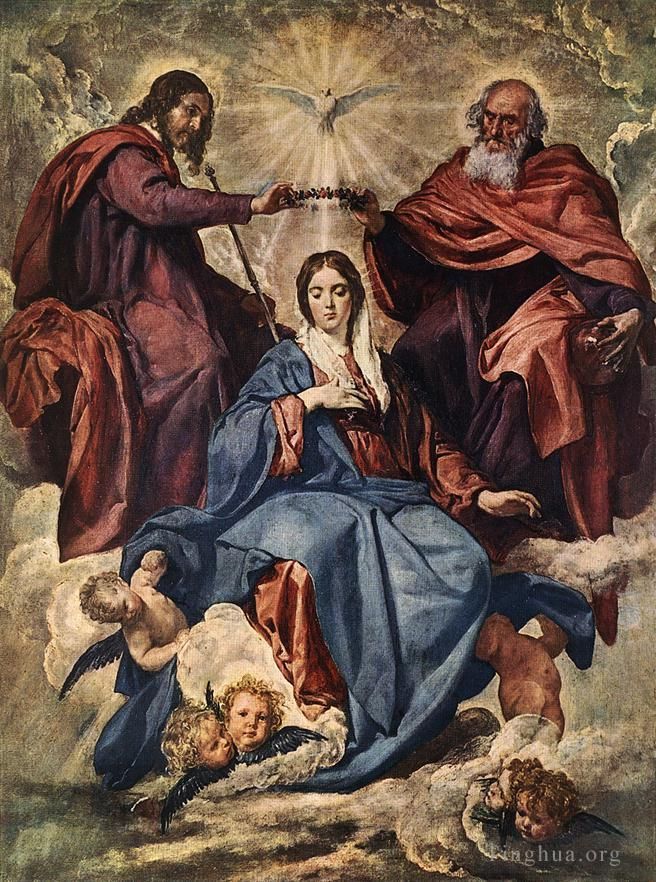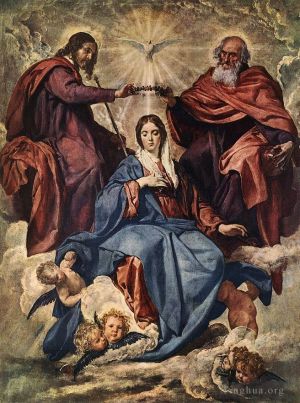The Coronation of the Virgin
Diego Velazquez
- Price: Price on Request
- Art Type: Oil Painting
- Size:
- English Comments: 0
- International Comments: 0
- Creating Date:
- Introduction and Works of Diego Velazquez >>
Keywords:
Coronation, Virgin
Work Overview
- The Coronation of the Virgin
Diego Velázquez
1635 - 1636. Oil on canvas, 178.5 x 134.5 cm
Velázquez painted The Coronation of the Virgin for Queen Elizabeth of Bourbon`s new prayer chapel at Madrid`s Alcázar palace, where it was intended to complete the series of nine paintings by Alessandro Turchi on The Feasts of Our Lady that Cardinal Gaspar de Borja y Velasco had sent to Madrid from Rome in 1635 or earlier. This was Velázquez`s last religious painting. The prayer chapel was on the second floor of the Alcázar, in the Galería del Cierzo, and was decorated with mural paintings by Angelo Nardi and an altarpiece build by Martín Ferrer on plans by Juan Gómez de Mora (now lost). Fifty-four paintings were hung there -probably in 1636- including Federico Barocci`s large Christ on the Cross (P07092). The iconography of Velázquez`s Coronation of the Virgin is traditional, following earlier models by Dürer and El Greco. The cherub leaning back on the right recalls a similar one in an engraving by Schelte of Bolswert after Rubens` Assumption of the Virgin. The canvas`s dimensions and the smaller-than-life-size figures are unusual for Velázquez and may reflect his need to adapt to the pre-existing series of paintings. Even the Virgin`s gesture, with one hand on her bosom, may have been intended to recall the Virgin`s left hand in Turchi`s Annunciation (P3166).
The Coronation is often dated from the early 1640s, but there are highly credible indications that it was painted in 1636. Antonio Palomino, whose chronology is usually quite precise, considers it contemporaneous with The Surrender of Breda, which was almost certainly completed in April 1635: At that time, he also painted a large historical painting of the Taking of a Plaza by Señor Don Ambrosio Espínola (...); as well as another of the Coronation of Our Lady, which was in the prayer chapel at the Queen`s quarters at the Palace (Palomino, [1724] 1986, p. 171). Exclusively on the basis of technical data, Carmen Garrido has convincingly argued that its execution corresponds to works painted by Velázquez around 1653. While Ceballos recently proposed that Borja may have commissioned Velázquez to paint this work for the queen after he returned to Madrid, it may also have been commissioned directly by the queen, or by the king as a present to decorate his wife`s prayer chapel. Velázquez has always been recognized as its author, except in a curious lapse in 1735, when it was listed among the works saved from the December 1734 fire at the Alcázar as an original by Racionero Cano (Text from Finaldi, G.: Fábulas de Velázquez. Mitología e Historia Sagrada en el Siglo de Oro, Museo Nacional del Prado, 2007, p. 325).
- Copyright Statement:
All the reproduction of any forms about this work unauthorized by Singing Palette including images, texts and so on will be deemed to be violating the Copyright Laws.
To cite this webpage, please link back here.
- >> English Comments
- >> Chinese Comments
- >> French Comments
- >> German Comments
- >>Report
- Philip IV
- View of the Gardens of the Villa Medici Rome
- Buffoon Barbarroja
- Pope Innocent X
- Don Luis de Gongora y Argote
- The Surrender of Breda
- Three Musicians aka Musical Trio
- Lady with a Fan
- Two Young Men at a Table
- Old Woman Frying Eggs
- Prince Felipe Prospero
- The Infanta Don Margarita de Austria
- The Toilet of Venus (Venus at her Mirror or The Rokeby Venus)
- Queen Isabel
- Mpther Jeronima de la Fuente
- De Acedo El Primo
- Pablo de Valladolid
- Philip IV in Brown and Silver
- Philip IV Standing
- Philip IV as a Hunter
- Juan de Pareja
- A Dwarf Holding a Tome in His Lap aka Don portrait Diego de Acedo el Primo
- Innocent X
- Young Man 1629
- The Poet Don Luis de Gngora y Argote
- Infante Don Carlos
- Sebastian de Morra
- Democritus
- Infante Philip Prosper dog
- Cardinale Ferdinand
- Portrait of a Man
- The Spinners (The Fable of Arachne)
- The Buffoon Calabazas2
- Philip IV 1624
- Philip IV Standing2
- Saint Paul
- Portrait of the Infanta Margarita
- Vulcan’s Forge
- Philip IV at Fraga
- Infante Philip Prosper
- Portrait of a Little Girl
- Head of a Deer
- Don portrait Diego del Corral y Arellano
- Portrait of a Man with a Goatee
- King Philip IV as a Huntsman
- Miguel Angelo Barber to the Pope
- Court Dwarf Don Antonio el Ingles
- Jester Don Juan de Austria
- The Buffoon Juan de Austria
- The Lunch (Luncheon or Breakfast)
- Young Peasant Girl
- The Temptation of St Thomas Aquinas
- St Ildefonso Receiving The Chasuble From The Virgin
- The Dwarf Francisco Lezcano
- Mercury and Argus
- Portrait of Innocent X
- A Sibyl
- Dona Antonia de Ipenarrieta y Galdos with Her Son
- Las Meninas
- The needlewoman
- Camillo Massimi
- Don Gaspar de Guzman Count of Olivares and Duke of San Lucar la Mayor
- Self
- A Dwarf Sitting on the Floor
- Queen Isabel Standing
- Prince Baltasar Carlos in Hunting Dress
- Supper at Emmaus
- John at Patmos
- Portrait of a Cleric
- Dona Antonia de Ipenarrieta y Galdos and her Son Luis
- Don Cristobal Suarez de
- Philip IV In Armour 1628
- Study For The Head Of Apollo
- Menippus
- Abbess Jeronima de la Fuente
- Francesco II dEste Duke of Modena
- Aesop
- A Young Lady
- Portrait of a Young Man 1626
- Francisco Bandres de Abarca
- Juan Martinez Montanes
- Queen Dona Mariana of Austria
- Josephs bloody coat
- Christ in the House of Mary and Marthe
- Philip IV on Horseback
- 4Velazquez Portrait of the Infanta Margarita
- The Buffoon Pablo de Valladolid
- View of Zaragoza
- Mars
- Maria Teresa of Spain with two watches
- Don Juan Mateos
- Dona Maria de Austria
- Don Gaspar de Guzman Count of Oliveres and Duke of San Lucar la Mayor2
- The Feast of Bacchus (The Triumph of Bacchus or Los borrachos)
- Portrait of Philip IV
- Sibyl
- Saint John at Patmos
- Don Baltasar Carlos with a Dwarf
- The Buffoon Don Cristobal de Castaneda y Pernia aka Red Beard
- The Buffoon Calabazas
- A Knight of the Order of Santiago
- Don Balthasar Carlos
- Saint Anthony Abbot and Saint Paul the Hermit
- THe Waterseller of Seville
- The Farmers Lunch (Peasants at the table)
- Infanta Marguarite Therese
- Prince Baltasar Carlos on Horseback
- Kitchen Scene With The Supper In Emmaus
- The crucified Christ
- The Adoration of the Magi
- Archne A Sybil
- The Sculptor Martinez Montanes
- The Coronation of the Virgin
- Velasquez2
- The Dwarf Don Juan Calabazas called Calabacillas
- Los Borrachos The Triumph of Bacchus
- Allegorical Portrait of Philip IV
- Cardinal Camillo Astalli
- The White Horse
- The Immaculate Conception
- Velasquez1
- Head Of A Girl
- Gaspar de Guzmán Count-Duke of Olivares on Horseback









 Singing Palette
Singing Palette